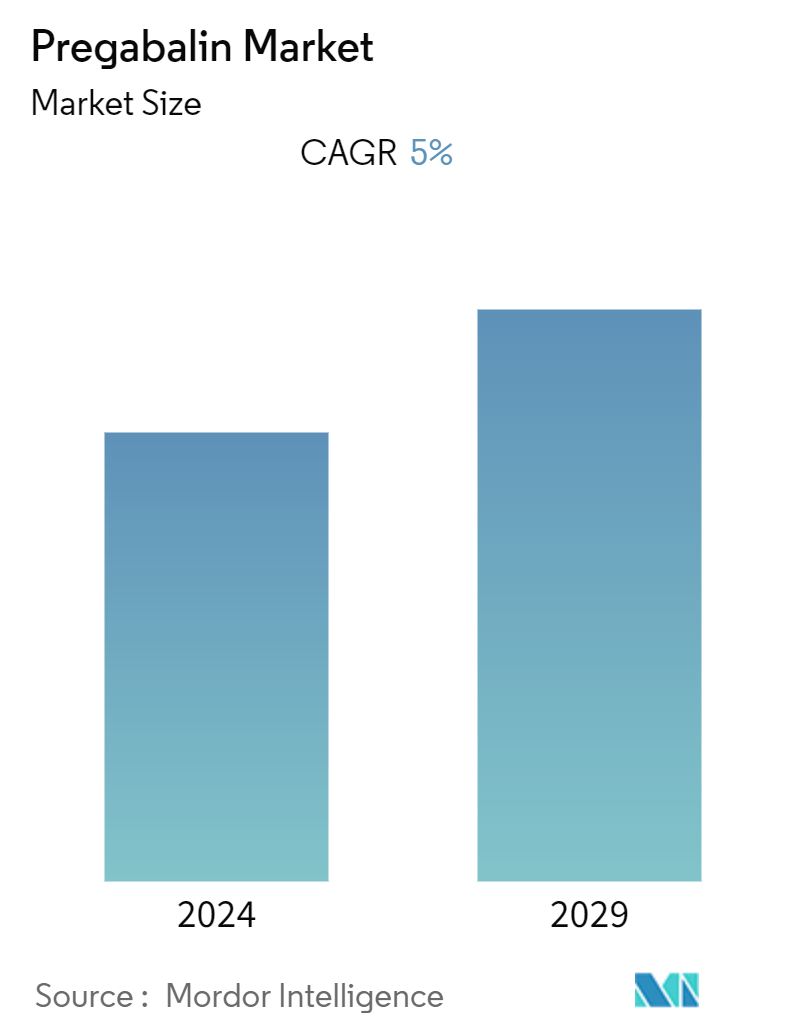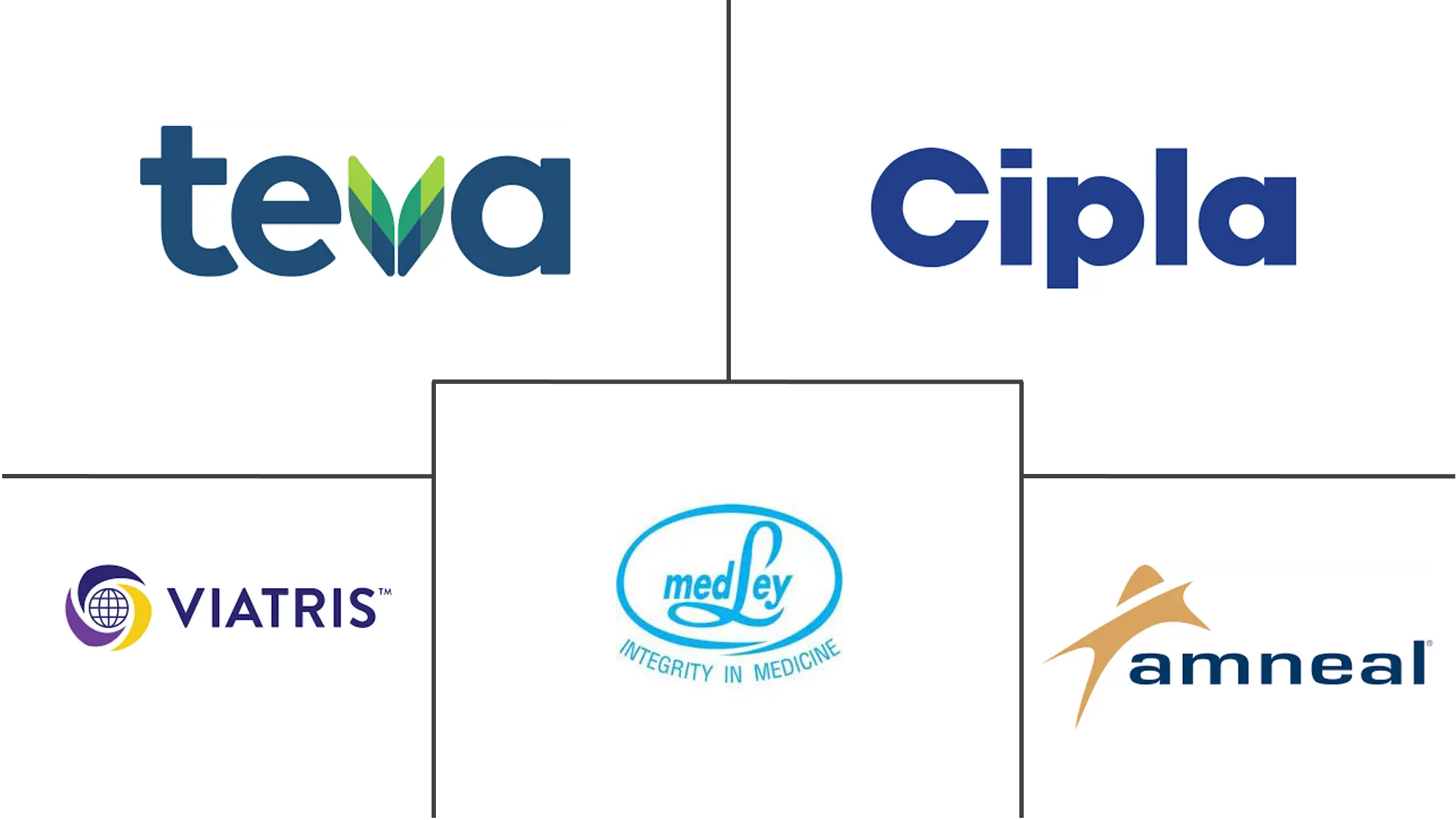Market Size of Pregabalin Industry

| Study Period | 2019 - 2029 |
| Base Year For Estimation | 2023 |
| Forecast Data Period | 2024 - 2029 |
| CAGR (2024 - 2029) | 5.00 % |
| Fastest Growing Market | Asia Pacific |
| Largest Market | North America |
Major Players
*Disclaimer: Major Players sorted in no particular order |
Pregabalin Market Analysis
The Pregabalin Market is expected to register a CAGR of 5% during the forecast period.
The high and growing prevalence of epilepsy and related disorders, such as neuropathic pain and anxiety disorders, are expected to be primary growth factors for the pregabalin market. Pregabalin is used in the management and treatment of these disorders. For instance, according to the February 2022 update of the World Health Organization, epilepsy was diagnosed in about 50 million people worldwide, with 80% of this population residing in low- and middle-income countries. Further, as per the same source, about 5 million cases of epilepsy were diagnosed yearly. As per estimates, up to 70% of people living with epilepsy could avoid seizures with the right diagnosis and care. Thus, with the increasing awareness about the disease, the demand for effective treatment is expected to increase, fueling market growth.
The rising geriatric population with neuropathic pain is expected to fuel growth in the pregabalin market further as pregabalin is used in neuropathic pain treatment. As the geriatric population increases around the world, the burden of neuropathic pain is further expected to increase over the forecast period. For instance, according to the United Nations Department of Economic and Social Affairs 2022, 771 million people were 65 years or over globally in 2022, and the elderly population is projected to reach 994 million by 2030 and 1.6 billion by 2050. As the elderly population is highly prone to complications such as painful diabetic neuropathy and post-herpetic neuralgia, the rising elderly population is anticipated to propel market growth.
The introduction of new products to the market is anticipated to drive further growth in the industry during the forecast period. For example, in May 2022, Lupin Pharmaceuticals received approval from the FDA for its ANDA for pregabalin capsules in a range of dosages (25 mg, 50 mg, 75 mg, 100 mg, 150 mg, 200 mg, 225 mg, and 300 mg). Therefore, the launch of generic pregabalin is anticipated to drive market growth due to cost-effectiveness and increased availability.
Hence, due to the abovementioned factors, the pregabalin market is expected to grow during the forecast period. However, the availability of alternative treatments, adverse effects associated with pregabalin, and stringent regulatory policies are expected to restrain the pregabalin market during the forecast period.
Pregabalin Industry Segmentation
As per the scope of the report, pregabalin is an anti-convulsive drug used to treat epilepsy, fibromyalgia, neuropathic pain, and other related disorders. It acts by reducing nervous activity and reduces pain. The pregabalin market is segmented by product, application, and geography. By products, the market is segmented as capsules, oral solutions, and other products. By application, the market is segmented as epilepsy, neuropathic pain, anxiety disorder, and other applications. By geography, the market is segmented into North America, Europe, Asia-Pacific, and Rest of the World. The report offers the value (USD) for the above segments.
| By Product | |
| Capsules | |
| Oral Solutions | |
| Other Products |
| By Application | |
| Epilepsy | |
| Neuropathic Pain | |
| Anxiety Disorder | |
| Other Applications |
| By Geography | ||||||||
| ||||||||
| ||||||||
| ||||||||
| Rest of the World |
Pregabalin Market Size Summary
The pregabalin market is poised for growth, driven by the increasing prevalence of neuropathic pain, epilepsy, and anxiety disorders. The COVID-19 pandemic has had a notable impact, with studies indicating a rise in neuropathic pain among infected individuals, potentially boosting pregabalin adoption. The drug's application in treating epilepsy and anxiety disorders is expected to see heightened demand due to the global increase in these conditions. The geriatric population, particularly susceptible to neuropathic pain, further propels market expansion. The introduction of new products, such as generic pregabalin, enhances market accessibility and cost-effectiveness, contributing to the anticipated growth during the forecast period.
North America is expected to witness significant market growth, attributed to the high prevalence of epilepsy and related disorders, alongside a robust presence of key market players. The region's market expansion is supported by new product approvals and a strong demand for pregabalin to address neurological disorders. The competitive landscape is characterized by the presence of established players and the ongoing launch of various pregabalin formulations. Despite potential challenges from alternative treatments and regulatory hurdles, the pregabalin market is set to grow, driven by the rising demand for effective management of neuropathic pain and related conditions.
Pregabalin Market Size - Table of Contents
-
1. MARKET DYNAMICS
-
1.1 Market Overview
-
1.2 Market Drivers
-
1.2.1 Growing Prevalence of Epilepsy and Related Disorders
-
1.2.2 Rising Geriatric Population with Neuropathic Pain
-
-
1.3 Market Restraints
-
1.3.1 Stringent Regulatory Policies
-
1.3.2 Availability of Alternatives and Adverse Effects Related to Pregabalin
-
-
1.4 Porter's Five Forces Analysis
-
1.4.1 Bargaining Power of Suppliers
-
1.4.2 Bargaining Power of Buyers/Consumers
-
1.4.3 Threat of New Entrants
-
1.4.4 Threat of Substitute Products
-
1.4.5 Intensity of Competitive Rivalry
-
-
-
2. MARKET SEGMENTATION (Market Size by Value - USD)
-
2.1 By Product
-
2.1.1 Capsules
-
2.1.2 Oral Solutions
-
2.1.3 Other Products
-
-
2.2 By Application
-
2.2.1 Epilepsy
-
2.2.2 Neuropathic Pain
-
2.2.3 Anxiety Disorder
-
2.2.4 Other Applications
-
-
2.3 By Geography
-
2.3.1 North America
-
2.3.1.1 United States
-
2.3.1.2 Canada
-
2.3.1.3 Mexico
-
-
2.3.2 Europe
-
2.3.2.1 Germany
-
2.3.2.2 United Kingdom
-
2.3.2.3 France
-
2.3.2.4 Italy
-
2.3.2.5 Spain
-
2.3.2.6 Rest of Europe
-
-
2.3.3 Asia-Pacific
-
2.3.3.1 China
-
2.3.3.2 Japan
-
2.3.3.3 India
-
2.3.3.4 Rest of Asia-Pacific
-
-
2.3.4 Rest of the World
-
-
Pregabalin Market Size FAQs
What is the current Pregabalin Market size?
The Pregabalin Market is projected to register a CAGR of 5% during the forecast period (2024-2029)
Who are the key players in Pregabalin Market?
Teva Pharmaceuticals, Cipla Limited, Medley Pharmaceuticals Limited, Viatris Inc. and Amneal Pharmaceuticals LLC are the major companies operating in the Pregabalin Market.

